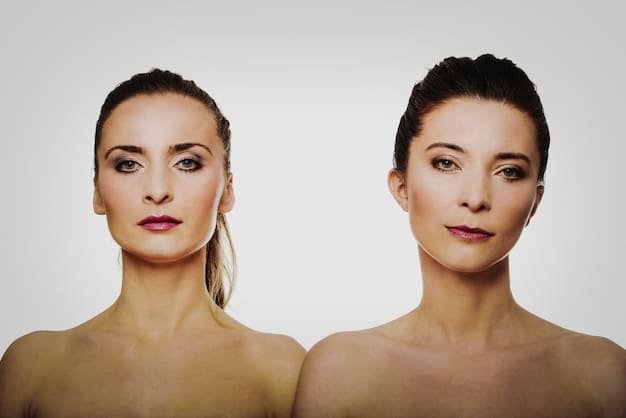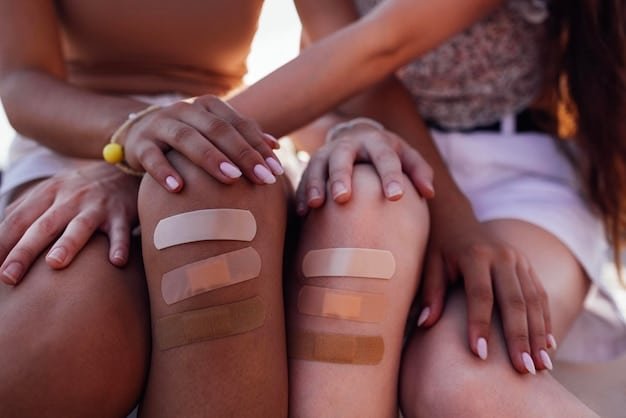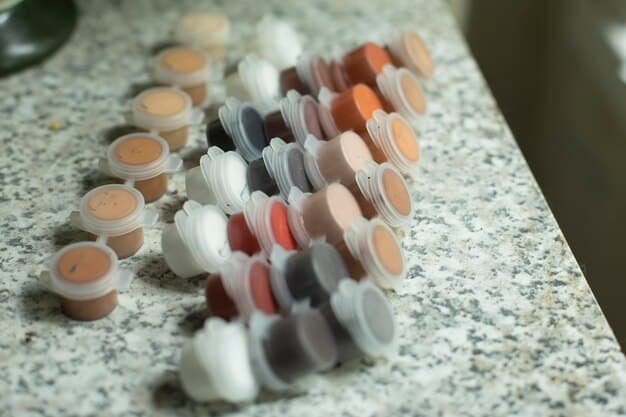How to Choose Concealer for Dark Circles: US Guide for All Skin Tones

Choosing the right concealer for dark circles involves understanding your skin tone, the darkness of your circles, and the concealer’s formula and undertone to achieve a natural, flawless look.
Dark circles can be a persistent beauty concern for many in the US, regardless of skin tone. Knowing how to choose the right concealer for dark circles: a comprehensive guide for all skin tones in the US, is crucial for achieving a bright, even complexion.
Understanding Dark Circles
Before diving into concealer selection, it’s essential to understand the nature of dark circles. They can be caused by various factors, including genetics, lack of sleep, dehydration, and even allergies. Identifying the cause will help you manage and conceal them effectively.
What Causes Dark Circles?
Dark circles aren’t always due to fatigue. Understanding the root cause helps tailor your concealer approach.
- Genetics: Some are simply predisposed to thinner skin under the eyes, making blood vessels more visible.
- Lifestyle Factors: Lack of sleep, poor diet, and dehydration can exacerbate dark circles.
- Medical Conditions: Allergies and eczema can lead to inflammation and discoloration.
In summary, dark circles are often a combination of factors. Addressing lifestyle issues and choosing the right concealer is key.
Identifying Your Skin Tone and Undertone
Choosing the right concealer starts with knowing your skin tone (light, medium, dark) and undertone (warm, cool, neutral). This knowledge ensures the concealer blends seamlessly with your skin for a natural finish.

How to Determine Your Skin Tone
This is about the surface shade of your skin.
- Light: Fair to light beige.
- Medium: Olive to tan.
- Dark: Deep brown to ebony.
- Undertone is key: undertone refers to the subtle hint of color beneath the surface of your skin. This can be warm, cool, or neutral.
Understanding this helps narrow down the best concealer options for a harmonious blend.
Choosing the Right Concealer Shade
Once you know your skin tone and undertone, selecting the right concealer shade becomes easier. Generally, choose a concealer that is one to two shades lighter than your natural skin tone to brighten the under-eye area.
The right shade of concealer is key to effectively concealing dark circles.
Understanding Undertones is Key:
- Warm Undertones: Look for concealers with peach or golden hues.
- Cool Undertones: Opt for concealers with pink or red hues.
- Neutral Undertones: Choose concealers with a balance of both warm and cool tones.
Selecting the right shade helps to neutralize the darkness without looking ashy or unnatural.
Concealer Formulas and Textures
Concealers come in various formulas, including liquid, cream, stick, and powder. The best formula depends on your skin type and the severity of your dark circles. Liquid concealers are versatile and suitable for most skin types. Cream concealers offer more coverage and are great for dry skin. Stick concealers are convenient for on-the-go touch-ups, while powder concealers are ideal for setting liquid or cream formulas.
Liquid Concealers
This type is versatile and widely used.
Cream Concealers
These are moisturizing and offer great coverage.
Stick Concealers
Excellent for spot correction.

Knowing which to use based on your skin and the darkness of your circles is essential for achieving the best results.
Application Techniques for Dark Circles
Applying concealer correctly can make a significant difference. Use a light hand and build coverage gradually. Start by applying small dots of concealer in the inner corner of your eye, where darkness is usually most prominent. Blend outwards using a damp makeup sponge or your fingertips.
Perfecting your concealer application can transform your under-eye area.
Effective Application Tips:
- Use a Primer: This creates a smooth base for the concealer.
- Apply in Thin Layers: Building coverage prevents caking.
- Set with Powder: This prolongs the wear of the concealer.
These techniques ensure a flawless finish that lasts all day.
Setting Your Concealer
Setting your concealer with a lightweight powder is crucial to prevent creasing and ensure long-lasting wear. Use a finely milled translucent powder and a fluffy brush. Gently press the powder onto the concealed area, focusing on areas prone to creasing, such as the under-eye area and smile lines.
Setting your concealer is essential for a long-lasting, flawless finish.
Common Setting Mistakes:
- Using Too Much Powder: This can lead to a dry, cakey look.
- Skipping Setting Spray: A spritz of setting spray helps meld everything together.
- Not Choosing the Right Powder: Opt for a finely-milled, translucent powder.
Correcting these common mistakes will enhance your concealer’s performance and appearance.
Additional Tips and Tricks
Besides choosing the right concealer and applying it correctly, there are additional tips and tricks to enhance your under-eye area. Use a color corrector to neutralize darkness before applying concealer. Orange or peach correctors work well for dark circles on deeper skin tones, while pink or salmon correctors are better for lighter skin tones.
Mastering these additional tips can make a huge difference in concealing dark circles.
Essential Tips:
- Stay Hydrated: Drinking plenty of water improves skin elasticity and reduces the appearance of dark circles.
- Get Enough Sleep: Aim for 7-8 hours of sleep per night to reduce puffiness and dark circles.
- Use a Cold Compress: Apply a cold compress to your eyes for a few minutes to reduce inflammation and puffiness.
By implementing these lifestyle adjustments, you can address the root causes of dark circles and complement your concealer routine.
| Key Point | Brief Description |
|---|---|
| 🧐 Understand Causes | Identifying reasons can help manage and conceal dark circles properly. |
| 🎨 Skin & Undertone | Know your skin and undertone for a flawless concealer blend. |
| ✨ Right Shade | Choose one to two shades lighter to brighten the under-eye area. |
| ✔️ Application | Use light layers and blend properly for perfect look. |
Frequently Asked Questions (FAQs)
▼
Cream concealers are generally the best choice for dry skin, as they provide more hydration. They also offer good coverage without accentuating dryness or fine lines.
▼
Preventing creasing involves using a light hand when applying concealer, setting it with a finely milled powder, and using a hydrating eye cream underneath to keep the area moisturized.
▼
Yes, you can definitely use concealer without foundation. It’s perfect for spot concealing blemishes or dark circles for a natural, makeup-free look. Just ensure it blends well with your skin.
▼
The color corrector depends on skin tone. Peach or orange correctors work best for dark circles on deeper tones, while pink or salmon shades are ideal for those with lighter skin.
▼
You should replace your concealer every 6-12 months to prevent bacterial contamination. Pay attention to any changes in texture, smell, or color as indicators of spoilage.
Conclusion
Choosing the right concealer and mastering the application techniques can significantly reduce the appearance of dark circles. By understanding your skin tone, selecting the appropriate formula, and employing the right application methods, you can achieve a brighter, more refreshed look in the US.





